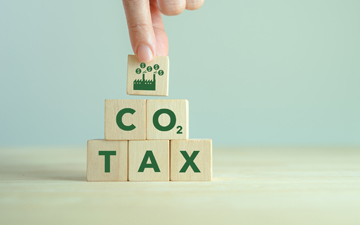Canadians are being given muddied information about the carbon tax; the facts are crystal clear — it saves money for most

Pierre Poilievre’s axe the tax message ignores the benefits of the carbon tax for most Canadians and avoids its real target — corporations and the wealthy
BRAMPTON – On October 15, Brampton resident Navjot Kaur, like many Canadians, noticed a $140 deposit in her account labeled as the Canada Carbon Rebate. She saw it as good news without paying much attention to it.
Like the vast majority of Canadians, as confirmed by a recent independent parliamentary report, the carbon tax is a net benefit for residents across Peel and the rest of the GTA.
“If you live in an eligible province, and you filed your taxes, you’ll get the Canada Carbon Rebate automatically — four times a year,” Prime Minister Justin Trudeau had explained in a post on X.
The carbon rebate has been a contentious issue between Liberals and Conservatives for years, with Pierre Poilievre vowing to “axe the tax” and eliminate carbon pricing for consumers and corporations if he is elected prime minister.
The Parliamentary Budget Officer’s report, released two weeks ago, details the clear benefits of the tax for more than 50 percent of Canadians, but this is not how Poilievre wants voters to see it.
Accounting for annual increases to the carbon tax to 2031, the data show it will continue to be a significant net benefit for Canadians who most need help to counter the high cost of living. (Backstop provinces are those that do not have their own carbon pricing system: Ontario, New Brunswick, Newfoundland/Labrador, Nova Scotia, Prince Edward Island, Manitoba, Alberta and Saskatchewan.)
The data above even include questionable modelling that weighs broad economic implications of the tax, dramatically reducing the reported benefits, but despite this new analysis by the PBO, Canada’s carbon pricing still puts more money into the pockets of more than 50 per cent of households.
With the new methodology, which fails to consider the economic benefits of emissions reductions, 60 per cent of residents in Saskatchewan, for example, will still see a net benefit of $606, on average, in 2030-31, when the tax is far higher than what it is now.
The Conservative Leader has ignored this, instead highlighting the impact of the tax on the wealthiest Canadians, those who do not experience the same acute financial hardships as most households.
His interpretation of the new PBO data relies on averages, dramatically misrepresenting the impact of carbon pricing on most Canadians. For example, when the 20 percent of Saskatchewan households who represent the top income quintile are removed from the data, the average benefit of the tax to the remaining 80 percent of households in the province is $126, on average, in 2030-31. But when those wealthiest households are added in, suddenly the average for everyone changes to a net loss of $894. This is due to the large disparity in the impact on the lowest-income households (a benefit of $1,275) and those in the highest income quintile (a cost of $4,970).
Poilievre is using the much higher cost figures and ignoring the numbers that represent the benefits of the tax to those Canadians who need help the most. Meanwhile, those wealthiest Canadians who pay an outsized amount because of the tax, are the households it is supposed to impact, to help change their carbon intensive lifestyles.
While the PBO report includes particular economic impacts of the carbon tax, Thomas Green, Senior Climate Policy Adviser at the David Suzuki Foundation, argues that it “fails to account for how climate change is already damaging the economy and costing Canadians.”
A report by the Canadian Climate Institute titled Damage Control: Reducing the Costs of Climate Impacts in Canada estimates that by 2030, Canada could experience annual losses of $35 billion in real GDP.
“By 2025, the previous 10 years of climate change will have shaved $25 billion off of national GDP. In other words, the Canadian economy will be $25 billion dollars smaller than it would have been if global warming had stabilized in 2015,” the report highlights. If we fail to address the climate crisis, it will cost exorbitantly more than the minimal economic impacts currently being felt by the carbon price.
Macro GDP projections often obscure the severe impacts of climate change, as it’s not just certain economic impacts such as employment and investment income that need to be looked at, but also how these potential costs could actually be mitigated or even turned around by investments in solutions spurred by carbon pricing; and even without these possible benefits, in the absence of alternatives to carbon pricing, traditional economic assumptions fail to consider all the potentially devastating financial consequences of the status quo.
The study highlights that governments deal with the effects of climate change by funding the rebuilding of damaged infrastructure, covering increased healthcare costs and addressing damage from weather-related disasters which could “cost approximately $720 per person annually, with projections of rising costs to between $1,900 and $2,300 per person by 2050.”
The study found that households are expected to experience significant income losses, with low-income households being the most affected.
“Low-income households could see income losses of 12 per cent in a low-emissions scenario and 23 per cent in a high-emissions scenario by the end of the century,” the study warns.
The Institute for Sustainable Finance also suggests that failing to invest in emission reductions could cost Canada approximately twice its GDP by the end of the century.
Research consistently indicates that the costs of inaction on climate change far exceed the costs of taking action now through policies such as the carbon tax.
Green calls the latest PBO analysis “flawed” as it compares the impacts of the carbon tax to “a scenario without any replacement policy.”
The latest PBO report “fails to consider the benefits of how clean technology expands when there is a price on pollution,” Green added.
There are numerous flaws in the PBOs new methodology, for example, it assumes vehicle fuel costs per household using modelling but it is impossible to know how much one household spends to fuel its vehicles compared to another.
It is the use of averages, though, that skews the overall numbers dramatically, painting a picture of the costs of the tax which is heavily distorted by the impacts on the wealthiest Canadians. A much more useful approach would be to see how households and individuals in each income bracket are directly impacted by the tax, along with the use of median figures instead of averages.
By choosing to ignore the benefits to those Canadians facing the most severe financial issues, instead dwelling on the impacts to the wealthier, Poilievre continues to ignore the very intention of carbon pricing — to curb the heavy-polluting behaviour of corporations and individuals whose carbon footprint is out of line with the climate reality facing all of us.
When the price was set to rise from $65 to $80 per tonne of carbon on April 1, Poilievre aggressively demanded Trudeau "spike the hike" and has continued a constant barrage of attacks against the tax in general. He has yet to provide his own comprehensive plan to replace the carbon pricing levy or explain how he would ensure Canada’s global commitments to international emissions reductions targets would be met under a Conservative government.
Steven Guilbeault, Minister of Environment and Climate Change Canada, has indicated that the government has no intentions of halting the upcoming increases to the carbon tax, set to rise by $15 per tonne every year, while acknowledging that if emissions decline significantly, it may not be necessary to continue raising the rate beyond 2030.
The report by the Parliamentary Budget Officer (PBO), released October 10, assessed the economic impacts of the federal carbon tax on Canadian households, and reached conclusions similar to those of previous analyses, despite adjusting the methodology from findings published in 2022 and 2023.
The new approach, aimed to “provide a broader measure of the net cost to households”, uses “estimates of the loss in employment and investment income” that impact the economy more broadly due to the carbon tax.
But it fails to include in its theoretical modelling any economic benefits from the reduction of emissions as a result of the tax.
“Consistent with our previous reports, our updated analysis does not account for the benefits of reducing Canada’s emissions by, for example, reducing the economic costs of climate change.”
For the average household subject to the federal carbon tax—excluding those in Quebec and British Columbia—the PBO's latest report indicates they will receive more from the Canada Carbon Rebate than they pay in the fuel levy and related Goods and Services Tax (GST).
“Our updated estimates (fiscal impact only) show larger net gains (lower net costs) for average households across income quintiles in backstop provinces compared to our March 2023 distributional analysis,” the report highlights.
The table above excludes the economic factors such as impacts on employment and investment income that the previous table includes. These numbers reflect just the impacts of the carbon tax looking at the benefits provided to consumers through the federal government’s Canada Carbon Rebate.
Those 60 percent of Canadians in the lowest three income quintiles (the middle quintile generally includes some households that would benefit and some toward the higher income end of the bracket that would pay a small amount) stand to gain the most from the carbon rebate, providing valuable support for many families.
The rebates can make a significant difference. The province that will receive the highest benefits by 2030-31 is Saskatchewan where 60 percent of residents will get an average rebate of $1,369 while New Brunswick, the province receiving the lowest average rebate, will still see 60 percent of residents receiving an average of $349.33.
Meanwhile, Ontario households in the lowest three income quintiles will receive an average rebate of $452.33 by 2030-31.
Jamal Hyder, an accountant in Mississauga, notes that over the years while most of his clients have been happy receiving the carbon rebate, they often have questions: they ask him what the carbon tax is; why it is necessary; and they wonder why their rebate amounts differ from those of others.
Under the carbon tax formula, lower-income households are given credit for lower carbon use compared to higher-income households.
“Given that the (carbon tax) lowers employment and investment income, which makes up a larger share of total income for higher income households, their net cost is higher,” the report further explains.
The report also highlights that "broadly speaking," its latest analysis showed higher net gains and lower household costs compared to its previous findings.
In Ontario, the average household will see a net cost when factoring the newly applied economic impacts, with a $903 hit, on average, according to the latest report.
But here’s where the problem lies.
The report uses averages, which skew the data and distort the overall picture. Even factoring the newly applied economic obstacles, the carbon tax still directly benefits a majority of Canadians.
While some critics attribute rising living costs to carbon pricing, the Bank of Canada has made it clear that carbon pricing accounts for a tiny fraction of total price increases.
"Each year it contributes 0.15 percent, which has a relatively minor impact on year-over-year inflation," Bank of Canada Governor Tiff Macklem explained in a press conference last year.
Many misconceptions and a lack of awareness surrounding carbon pricing have contributed to the political spin around the tax.
“Canadians want to do their part to tackle global climate change. But the national discussion about the best policies to do so remains polarized…myths and misleading statements, however, continue to damage the debate over carbon pricing,” a 2019 Canada’s Ecofiscal Commision report highlighted.
The report argues that carbon pricing is a used and tested idea that has worked in both the U.S. and Europe. In the U.S., it reduced pollution that caused acid rain by 34 percent in 14 years by putting a price on it.
In Canada, Alberta initiated North America’s first carbon price in 2007, targeting greenhouse gas (GHG) emissions from large industrial emitters, followed by British Columbia in 2008 and Quebec in 2013.
Ontario implemented carbon pricing in 2015 but the policy was repealed by Doug Ford’s PC government almost immediately after being elected in 2018. In 2016, federal, provincial, and territorial governments agreed to adopt a coordinated strategy to help Canada meet its emissions targets, resulting in the Pan-Canadian Framework on Clean Growth and Climate Change, which outlines a collaborative approach to tackling climate change, with a key element being a price on carbon.
It also argues that the carbon pricing is anticipated to deliver significant long-term benefits, with short-term improvements being incremental.
As prices rise, demand for low-carbon solutions will increase, driving business innovation. Historical examples, such as the fuel efficiency improvements in American cars after the 1973 oil crisis, illustrate how policy can spur innovation.
Research has also shown that stronger environmental policies, including carbon pricing in Europe, have led to a notable rise in low-carbon patents for a range of innovative technologies to make everything from cars to heating systems more sustainable.
The cost of renewable energy has dramatically decreased, with large-scale solar costs dropping by 72 percent since 2010, highlighting how innovation can accelerate the transition to a cleaner economy under carbon pricing, which acts as both an incentive and disincentive.
The PBO report does estimate the carbon tax will increase the budgetary deficit by $1.5 billion in 2024-25, ultimately reaching $4 billion by 2030-31, but it does not include any factors related to the cost benefits of reducing climate change impacts.
Back in Brampton, Kaur, who has often overheard elders refer to the carbon tax as “a waste”, feels frustrated because they don’t understand it’s a “necessary tax.”
Since moving to Canada over six years ago, she has paid little attention to the carbon tax. Reflecting on it now, she wishes India, where she was brought up, had a similar system, especially when she has to suffer with the worsening water and air quality — something she notices “as soon as you land at Delhi International Airport.”
In 2021, India was ranked the fourth-largest greenhouse gas emitter, while Canada was 12th place. But our per capita ranking is among the worst, with Canadians producing more than 14 tonnes of carbon emissions per person in 2022, more than seven times India’s rate.
Canada's total emissions decreased by 1.4 percent from 2005 to 2021, falling from 686 to 677 million tonnes of CO2 (carbon dioxide) equivalent. This reduction was smaller than other western countries; the United States reduced emissions by 14.2 percent; and the European Union saw a 22.6 percent decrease during the same period.
“If Canada’s GHG emissions per year were shared equally by each person in Canada, each person would emit 17.7 tonnes of CO2 equivalent per year, which is 3 times the global rate. That is the same amount of GHG emissions released as someone driving around the world in a gasoline-powered car twice per year,” according to a recent Government of Canada report.
In 2023, over 250 of Canada’s leading economists signed a letter advocating for the effectiveness of carbon pricing in reducing emissions while imposing minimal costs on Canadians and the economy.
“The reason carbon pricing works is simple: when something costs more (in this case fossil fuels), people use less of it. That is basic economics, and common sense,” the letter underscored.
The 2024 edition of UNEP’s Emissions Gap Report stresses that current policies are “insufficient” and nations, particularly G20 members, must dramatically increase their commitments in new Nationally Determined Contributions (NDCs) and act swiftly to achieve them. Without significant progress, the goal of limiting global warming to 1.5 degree celsius will be unattainable within just a few years, with the target of keeping it below 2 degrees celsius in serious jeopardy.
“If nothing changes, we are heading for a temperature rise of 3.1 degrees celcius. The consequences for people, societies and economies of such extreme warming are unthinkable…Climate crunch time is here,” UNEP executive director Inger Andersen said at the launch of the report.
“Every fraction of a degree counts in terms of lives saved, economies protected, damages avoided, biodiversity conserved and the ability to rapidly bring down any temperature overshoot.”
Meanwhile Pierre Poilievre, who is bent on eliminating the carbon tax and its benefits to Canadians, has yet to present a plan backed by scientists to help solve the biggest threat facing all of us.
Anushka Yadav is a Local Journalism Initiative reporter with The Pointer in the Greater Toronto Area. Title image: iStock photo ID 1402051905.










(0) Comments